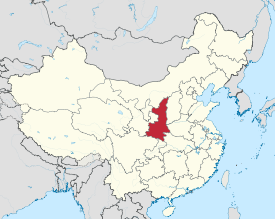This article needs additional citations for verification. (April 2019) |
Shaanxi
陕西 | |
|---|---|
| Province of Shaanxi | |
| Name transcription(s) | |
| • Abbreviation | SN / 陕 Shǎn / 秦 Qín |
(clockwise from top)
| |
 Map showing the location of Shaanxi Province | |
| Coordinates: 35°36′N 108°24′E / 35.6°N 108.4°E | |
| Country | China |
| Capital (and largest city) | Xi'an |
| Divisions | 10 prefectures, 107 counties, 1745 townships |
| Government | |
| • Type | Province |
| • Body | Shaanxi Provincial People's Congress |
| • CCP Secretary | Zhao Yide |
| • Congress chairman | Zhao Yide |
| • Governor | Zhao Gang |
| • CPPCC chairman | Xu Xinrong |
| • National People's Congress Representation | 71 deputies |
| Area | |
• Total | 205,800 km2 (79,500 sq mi) |
| • Rank | 11th |
| Highest elevation | 3,771 m (12,372 ft) |
| Population (2020)[2] | |
• Total | 39,530,000 |
| • Rank | 16th |
| • Density | 190/km2 (500/sq mi) |
| • Rank | 21st |
| Demographics | |
| • Ethnic composition |
|
| • Languages and dialects | Jin Chinese, Zhongyuan Mandarin |
| GDP (2023)[3] | |
| • Total | CN¥ 3,779 billion (14th)
US$ 479 billion |
| • Per capita | CN¥85,448 (12th; US$12,126) |
| ISO 3166 code | CN-SN |
| HDI (2022) | 0.792[4] (12th) – high |
| Website | shaanxi.gov.cn |
Shaanxi[a] is an inland province in Northwestern China. It borders the province-level divisions of Inner Mongolia to the north, Shanxi and Henan to the east, Hubei, Chongqing, and Sichuan to the south, and Gansu and Ningxia to the west. Shaanxi covers an area of over 205,000 km2 (79,151 sq mi) with about 37 million people, the 16th largest in China. Xi'an – which includes the sites of the former Chinese capitals Fenghao and Chang'an – is the provincial capital as well as the largest city in Northwest China[5] and also one of the oldest cities in China and the oldest of the Four Great Ancient Capitals, being the capital for the Western Zhou, Western Han, Jin, Sui and Tang dynasties.[6] Xianyang, which served as the Qin dynasty capital, is just north across Wei River. The other prefecture-level cities into which the province is divided are Ankang, Baoji, Hanzhong, Shangluo, Tongchuan, Weinan, Yan'an and Yulin.
The province is geographically divided into three parts, namely Northern, Central and Southern Shaanxi. Northern Shaanxi (or "Shaanbei") makes up the southeastern portion of the Ordos Basin and mainly comprises the two prefectural cities of Yulin and Yan'an on the northern Loess Plateau, demarcated from the Ordos Desert and the grasslands of Inner Mongolia's Ordos City by the Ming Great Wall. Central Shaanxi (or "Shaanzhong") is also known as the Guanzhong region and comprises the drainage basin of lower Wei River east of Mount Long and north of the Qinling Mountains, where the majority of Shaanxi's population reside. Southern Shaanxi (or "Shaannan") comprises the three prefectural cities in the edge of the historical Bashu region south of the Qinling Mountains and includes the three mountainous cities of Hanzhong, Ankang and Shangluo.
The area comprising Shaanxi, Shanxi, and Henan formed the cradle of Chinese civilization. In the Republican era of China, the city of Yan'an was near the endpoint of the Long March by the Chinese Red Army, who fled from Jiangxi after the Chinese Soviet Republic were destroyed by the Kuomintang armies, and became the birthplace of the Chinese Communist Revolution from late 1935 to early 1947 and the Communists formed the Shaan-Gan-Ning Border Region in constituent parts of Shaanxi.
The vast majority of the population of Shaanxi is Han Chinese, with Hui, Manchu and Mongol being the more significant ethnic minorities. Mandarin Chinese is the main spoken language in Shaanxi, including Zhongyuan Mandarin and Southwestern Mandarin dialects; another variety of Chinese, Jin Chinese, is also spoken in the regions neighboring Shanxi.
Shaanxi is China's 15th largest economy, ranking within the middle tier among China's administrative divisions. The fossil fuel and high technology sectors compose the two largest industries in Shaanxi Province. The high technology sector includes aircraft and aerospace industries and Shaanxi produces more than 50% of the R&D and manufacturing equipment for the country's domestic commercial aviation industry.[7]
- ^ "Doing Business in China – Survey". Ministry of Commerce of the People's Republic of China. Archived from the original on 26 May 2014. Retrieved 5 August 2013.
- ^ "Communiqué of the Seventh National Population Census (No. 3)". National Bureau of Statistics of China. 11 May 2021. Archived from the original on 1 October 2021. Retrieved 11 May 2021.
- ^ "National Data". China NBS. March 2024. Retrieved 22 June 2024.; see also "zh: 2023年陕西省国民经济和社会发展统计公报". shaanxi.gov.cn. 26 March 2024. Retrieved 22 June 2024.
- ^ "Human Development Indices (8.0)- China". Global Data Lab. Retrieved 23 September 2024.
- ^ 最新中国城市人口数量排名(根据2010年第六次人口普查). www.elivecity.cn (in Chinese (China)). Archived from the original on 3 March 2015. Retrieved 12 June 2019.
- ^ "Xi'an – MSN Encarta". 28 February 2008. Archived from the original on 28 February 2008. Retrieved 12 June 2019.
- ^ Cite error: The named reference
thechinaperspective.comwas invoked but never defined (see the help page).
Cite error: There are <ref group=lower-alpha> tags or {{efn}} templates on this page, but the references will not show without a {{reflist|group=lower-alpha}} template or {{notelist}} template (see the help page).




